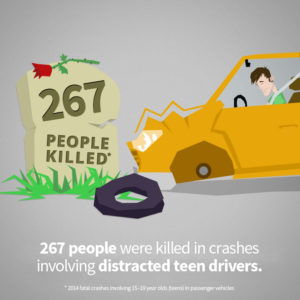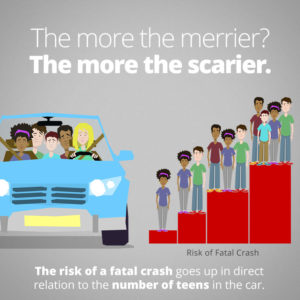 The Alliance for Safe Kids (ASK) and State Farm ® are joining with the National Highway Traffic Safety Administration during National Teen Driver Safety Week (October 15-21) to encourage all parents to talk to their teen drivers about the rules of the road.
The Alliance for Safe Kids (ASK) and State Farm ® are joining with the National Highway Traffic Safety Administration during National Teen Driver Safety Week (October 15-21) to encourage all parents to talk to their teen drivers about the rules of the road.
“Parents have a very strong influence on their teens, even as they grow older and become more independent,” said Liz Talbert, Executive Director at ASK. “NHTSA offers parents and caregivers tips and a framework to talk to their teen drivers about risky driving behaviors that can lead to fatal consequences.”
Motor vehicle crashes are the leading cause of death for teens in the United States – ahead of all other types of injury, disease or violence. In 2015, 1,972 teen passenger-vehicle drivers (15 to 18 years old) were involved in fatal traffic crashes, resulting in 2,207 deaths nationwide, of which 1,730 were teens. An estimated 99,000 teen drivers of passenger vehicles were injured in motor vehicle traffic crashes.
Parents can play an important role in helping ensure their teen drivers take smart steps to stay safe on the road. NHTSA gives parents tips on how to talk about safe driving behaviors with their teens and to address the most dangerous and deadly driving behaviors for teen drivers: alcohol, lack of seat belt use, distracted and drowsy driving, speeding, and driving with passengers.
NHTSA’s website, www.nhtsa.gov/road-safety/teen-driving, has detailed information and statistics on teen driving and outlines the basic rules parents can use to help reduce the risks for teen drivers:
- No Drinking and Driving. All teens are too young to legally buy, possess, or consume alcohol, but they are still at risk. Nationally in 2015, almost one out of five teen passenger vehicle drivers involved in fatal crashes had been drinking. Remind your teen that driving under the influence of any impairing substance, including illicit and prescription drugs, could have deadly consequences and is strictly enforced.
- Buckle Up—Every Trip, Every Time. Everyone—Front Seat and Back. Wearing a seat belt is one of the simplest ways for teens to stay safe in a vehicle and it is required in all 50 States. Yet too many teens are not buckling up, and neither are their passengers. In 2015, 531 passengers died in a car, truck, or SUV driven by a teen driver, and 58 percent of those passengers were NOT buckled up at the time of the fatal crash. Even more troubling, in 84 percent of cases when the teen driver was unbuckled, the passengers were also unbuckled. Remind your teen that it’s important to buckle up on every trip, every time, no matter what – front seat and back.
- Eyes on the Road, Hands on the Wheel. All the Time. Distractions while driving are more than just risky—they can be deadly and are outlawed in 47 States, Washington DC, Puerto Rico, Guam, and the U.S. Virgin Islands. In 2015, among teen passenger-vehicle drivers involved in fatal crashes, 10 percent were reported as distracted at the time of the crash. Remind your teen about the dangers of texting and using a phone while driving. Distracted driving isn’t limited to cell phone use; other passengers, audio and climate controls in the vehicle, and eating or drinking while driving are all examples of dangerous distractions for teen drivers.
- Follow the Posted Speed Limit. Speeding is a critical issue for all drivers, especially for teens. In 2015, almost one-third (29%) of teen passenger vehicle drivers involved in a fatal crash were speeding at the time of the crash. Remind your teen to always drive within the speed limit.
 Passengers in a teen’s car can lead to disastrous consequences. According to data analyzed by NHTSA, teen drivers were 2.5 times more likely to engage in one or more potentially risky behaviors when driving with one teenage peer, when compared to driving alone. The likelihood of teen drivers engaging in risky behaviors triples when driving with multiple passengers.
Passengers in a teen’s car can lead to disastrous consequences. According to data analyzed by NHTSA, teen drivers were 2.5 times more likely to engage in one or more potentially risky behaviors when driving with one teenage peer, when compared to driving alone. The likelihood of teen drivers engaging in risky behaviors triples when driving with multiple passengers.- Avoid Driving Tired. Teens are busier than ever – studying, extracurricular activities, part-time jobs, and spending time with friends are among the long list of things they do to fill their time. However, with all of these activities, teens tend to compromise something very important: sleep. This is a dangerous habit that can lead to drowsy driving. Make sure your teen gets a good night’s sleep; their grades, their friends, their passengers, and other drivers will thank them because they’ll be a safer driver.
Parents can help protect their teen drivers by talking with them about these risks. Surveys show that teens whose parents set firm rules for driving typically engage in less risky driving behaviors and are involved in fewer crashes.
Explaining the rules and any other restrictions outlined in New York’s graduated driver licensing (GDL) law and the deadly consequences of unsafe driving practices can help encourage teens to exhibit safe driving behaviors.
“Laws are not enough to protect these young drivers. We need parents to set the rules before their teens hit the road,” Talbert said. “We hope parents will start the conversation about safe driving during National Teen Driver Safety Week – but then continue the conversations—every day throughout the year—to help keep their teens safe behind the wheel.”
For more information about National Teen Driver Safety Week and safe driving tips for your teens, please visit www.nhtsa.gov/road-safety/teen-driving
.
